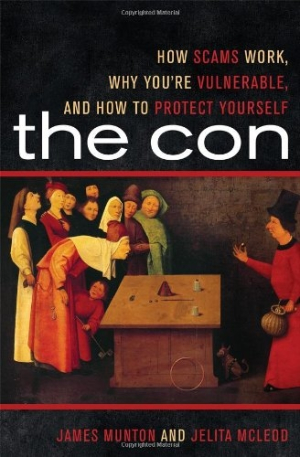The Con
How Scams Work, Why You're Vulnerable, and How to Protect Yourself
Although most people believe that they’re too smart or too protected to be conned, anecdotal and statistical evidence says otherwise. The scams may be small, like someone stealing a prescription drug bottle and refilling it under a fake name, or they could be vast Ponzi schemes that defraud thousands.
The range of scams is staggering, and this extremely thorough and timely guide details many common cons that could fool just about anyone. More importantly, it gives concrete tips on dealing with scammers and preventing such traps at the outset. For each scenario, the authors describe a con by using a fictional character who’s been duped, and the device works very well, making the material engaging, accessible, and understandable.
For example, in a section on mail-based scams, “Vivian” receives a package of cleaning products she didn’t order, and with it a sizeable bill, followed by threatening letters. She finally enlists the help of her company’s legal department, which helps her draft a menacing letter of her own, one that settles the matter. The authors note that such a tactic is used often, especially against businesses that might not notice a bogus invoice among real ones.
In short, straightforward sections, other cons are analyzed, such as telemarketers, emergency phone calls from fake relatives, door-to-door scams, check-bouncing tactics, and identity-theft strategies.
The authors bring considerable expertise to the task. James Munton is a magician who’s performed several times at the White House, and is now a speaker on the subjects of identity theft and data breaches, while Jelita McLeod’s journalistic background includes stories for the Washington Post and National Public Radio. That blend works well, since so many cons are much like magic tricks, with sleight-of-hand and misdirection, and it takes a reporter’s skill to really dig into why they succeed.
“For every con, there is a corresponding trait in human nature that is being targeted,” the authors warn. Understanding how cons work, why they prey on basic emotional needs, and what can be done to stop them are all vital in boosting protection. This compelling work goes a long way toward putting distance between scammers and their prey.
Reviewed by
Elizabeth Millard
Disclosure: This article is not an endorsement, but a review. The publisher of this book provided free copies of the book to have their book reviewed by a professional reviewer. No fee was paid by the publisher for this review. Foreword Reviews only recommends books that we love. Foreword Magazine, Inc. is disclosing this in accordance with the Federal Trade Commission’s 16 CFR, Part 255.

